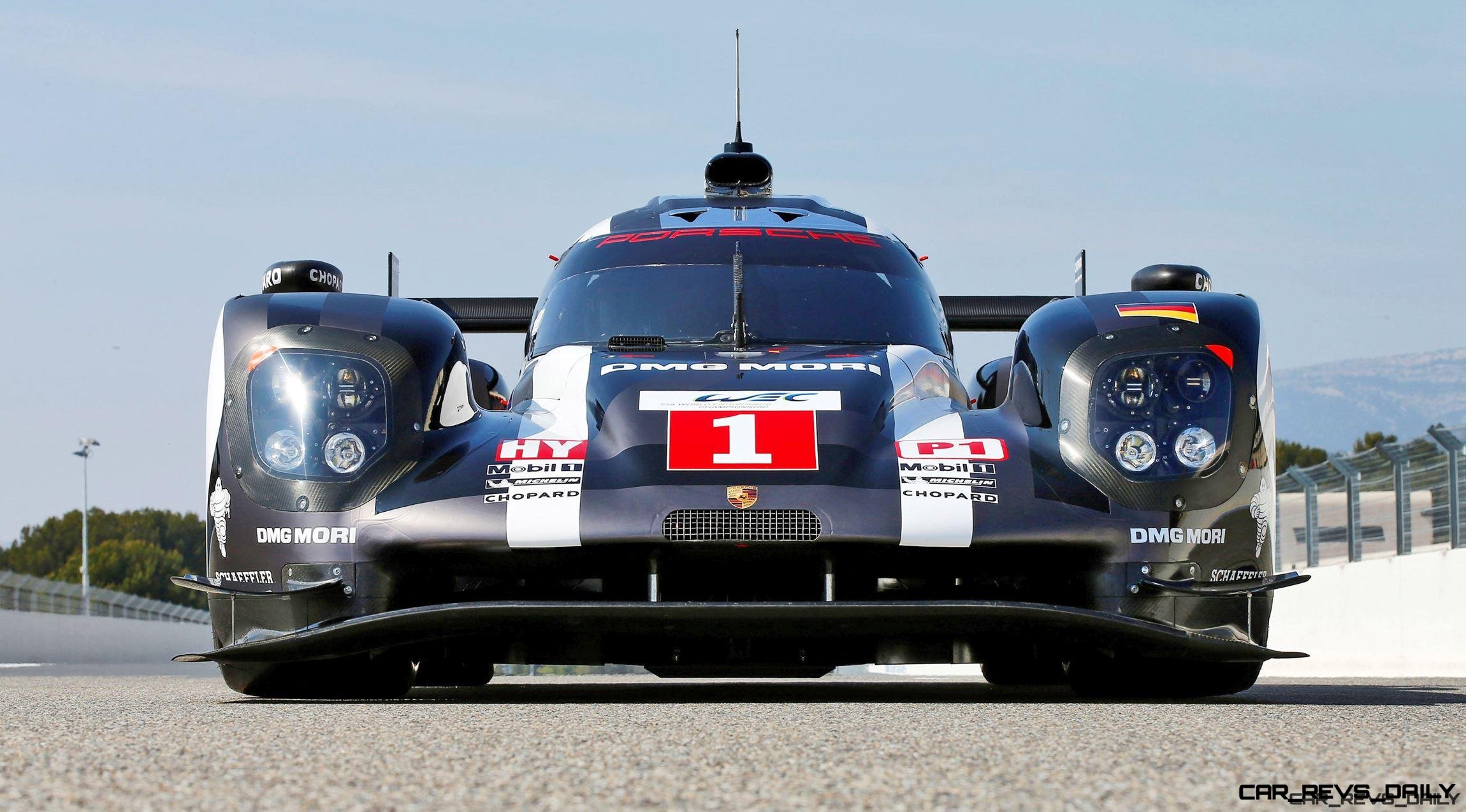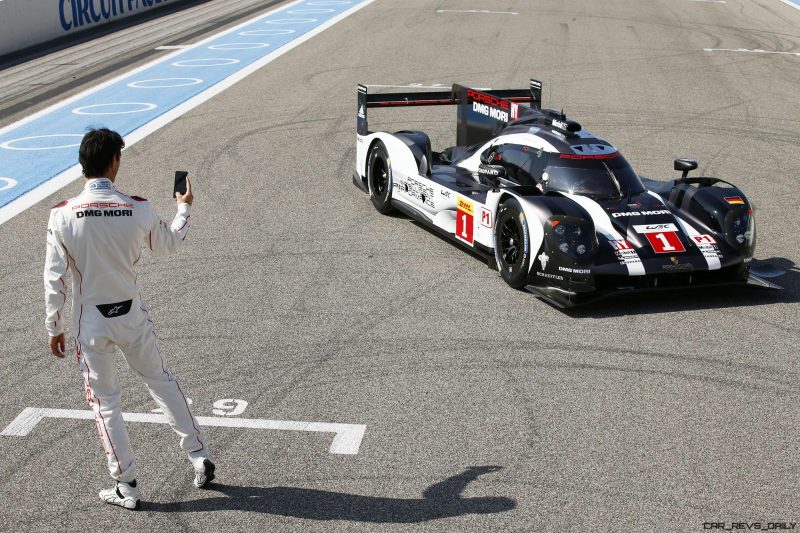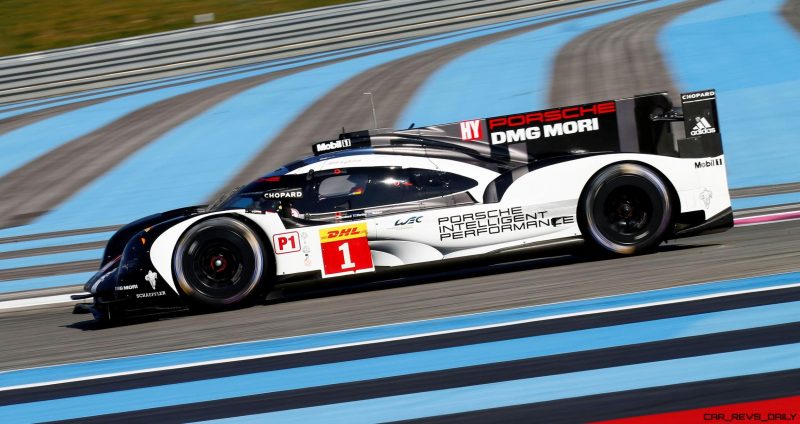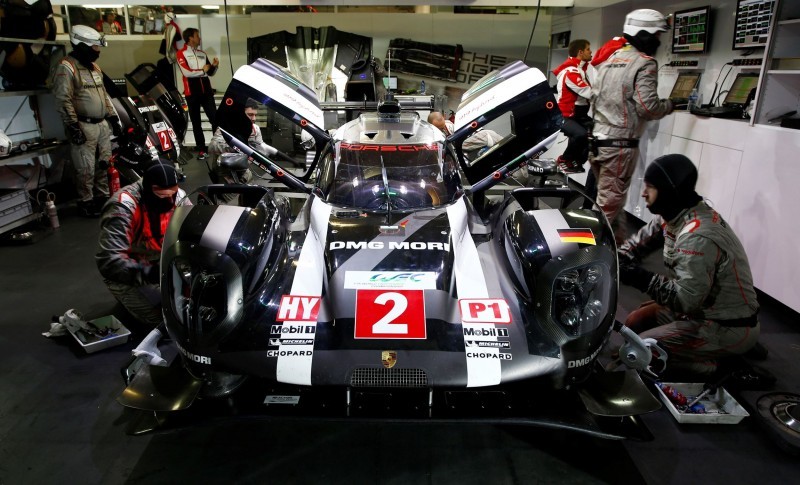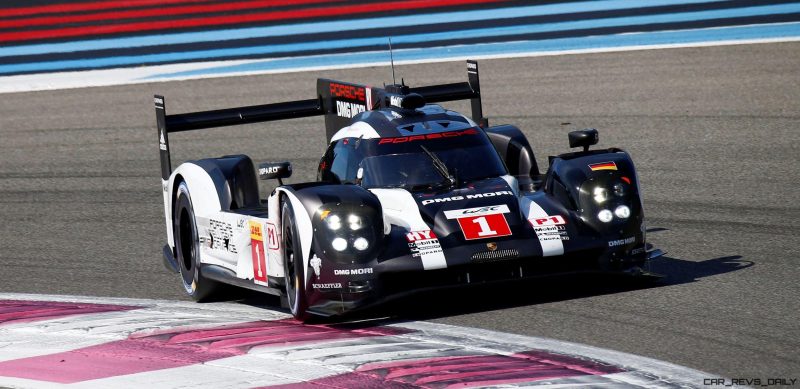In this way, the regulations prevent the Le Mans prototypes from becoming increasingly faster, yet at the same time fuel the engineers’ efforts to generate more power from increasingly less fuel. Maximising efficiency and electrification are the decisive aspects. Porsche’s road-going sports cars also benefit from the developments on the Le Mans 919 Hybrid racer.
Right from the start, by the first 919 for the maiden 2014 season, Porsche adopted a courageous concept, which turned out to be spot on. The first 2014-spec showed exceptional potential for 2015, on which a virtually new car for 2015 was based. Now, there is less need to change and Porsche is benefitting from the stability of the concept. With every detail, the engineers asked themselves if it’s possible to make it even more robust and extract even more performance. For 2016 no changes to the concept were necessary. Porsche was able to improve every area of the car without taking big risks. This characterises the 2016-spec vehicle. Like every Porsche, the 919 Hybrid was born at the R&D Centre in Weissach near Stuttgart.
Requirements
The regulations for the top category (Class 1 Le Mans Prototypes, or LMP1 for short) require manufacturers to use hybrid drive systems and establish a direct link between the sporty performance of the prototypes and their energy efficiency. Put simply, this means that a large amount of energy from recovery systems may be used. However, this entails a proportional reduction in the permitted amount of fuel per lap, and the quantity of fuel consumed in each lap is accounted for.
WEC officials allow engineers a great degree of freedom in terms of the hybrid drive concepts that may be employed. The teams can choose between diesel and petrol engines, naturally aspirated or turbocharged engines, various displacements, and one or two energy recovery systems. This formula puts the focus on innovations that will have a huge impact on future production sports cars – and this was the main reason why Porsche decided to return to the world of top level motor racing.
Combustion engine
Porsche made its début in 2014 with the most innovative drive system on the WEC grid line up. All components were again revamped for the 2016 season. The combustion efficiency of the 2-litre V4 turbocharged petrol engine, which drives the rear axle, was further increased. The LMP1 engineers in Weissach work closely with the engineers from production development. They significantly support developing the combustion engine and mixture preparation. LMP1 and production engineers also share the same dynos and test beds.
The appreciation and added value flow both ways: Technology elements from the Le Mans-winning motor have been adopted in the new turbo downsizing four-cylinder engines of the Porsche 718 Boxster production car. For instance, the cylinder spacing, the short-stroke design and the central direct fuel injection.
The four-cylinder unit mounted in the 919, however, is not a flat unit, but a V-engine with 90-degree cylinder bank angle. For 2016, it shed some more weight. Last season, the output of the combustion engine was well above 500 hp. The 2016 regulations stipulate an even lower amount of energy from fuel per lap and reduce the maximum fuel flow for all prototypes. For the 919, this means around eight per cent less fuel and power. Or in other words: ten megajoules less energy per Le Mans lap can be generated from fuel. That costs about four seconds for every 13.629-kilometre Le Mans lap. Through the new restrictions, the performance of the combustion engine has dropped to below 500 hp.
Energy recuperation systems
With the high efficiency of the combustion engine, the recovery systems and the batteries, Porsche was the first and only manufacturer in 2015 to be able to select the highest category for electrical energy: eight megajoules per Le Mans lap.
For 2016, the components of the electric drive have become even more powerful and efficient. That applies for the optimised electric motor at the front axle, the power electronics and the new generation of lithium-ion battery cells in the in-house developed battery.
The kinetic energy produced at the front axle when braking is converted into electrical energy. The second recuperation system is installed in the exhaust tract, where the exhaust-gas stream drives a second turbine – virtually in parallel with the turbocharger. It uses excess energy from the exhaust pressure that would otherwise escape into the environment. The VTG technology used here – that is, the variable adaptation of the turbine geometry to the level of exhaust pressure – drives the turbines, even at low engine revs and correspondingly low pressure. The additional turbine is directly connected to an electric generator. The electricity produced – along with that generated by the kinetic energy recovery system (KERS) at the front axle – is temporarily stored in lithium-ion battery cells. The driver can call up power from the cells, and if he engages the full-boost function, additional power output of more than 400 hp will thrust him back into his seat. This power is applied to the front axle by the electric motor, and it temporarily transforms the 919 Hybrid into an all-wheel drive race car with system power of around 900 hp. For each circuit, teams and drivers work permanently on developing the strategies for when and to what extent energy is recuperated and called up per boost.
Battery
The WEC regulations allow engineers plenty of scope with regard to the energy storage medium: Initially, the competition used flywheels and ultracaps (electrochemical supercapacitors). For 2016, they are all following Porsche’s lead of lithium-ion batteries. Another important fundamental decision with the 919 Hybrid was the high voltage of 800-Volt – a technology that series developers are adopting in the Mission E concept (see “Hybrid Drive” chapter).
In regard to the hybrid and battery development in particular, Oliver Blume, the CEO of Porsche AG, emphasises the pioneering role of the 919: “Thanks to our success with our electrified prototype, we now have substantial knowledge. For instance, we don’t need to buy electric motors ready-made for our production sports cars.”
Energy classes
The regulations distinguish between four levels ranging from 2 to 8 megajoules (MJ) of deployable energy. The calculation formula is based on the 13.629-kilometre lap in Le Mans, and the calculation is adjusted accordingly for the other eight racing circuits. If a team wants to utilise the 8 megajoules per lap that are permissible in the highest recuperation category, an FIA flowmeter device will limit the permitted amount of fuel per lap to 4.31 litres. By comparison, 4.70 litres of fuel can be used per lap in the 2-megajoule category. Engineers also have to take into account the fact that the more powerful the energy recovery and storage systems are, the bigger and heavier they tend to be. The Porsche 919 Hybrid was homologated for the top 8-megajoule category in 2015.
Energy/fuel use formulas for one lap in Le Mans*:
2 megajoules recovered energy = 4.70 litres petrol = 3.70 litres diesel
4 megajoules recovered energy = 4.54 litres petrol = 3.58 litres diesel
6 megajoules recovered energy = 4.38 litres petrol = 3.47 litres diesel
8 megajoules recovered energy = 4.31 litres petrol = 3.33 litres diesel
*valid from 01.01.2016 up to and including Le Mans 2016
Vehicle structure
Like in Formula 1, the Porsche 919 Hybrid monocoque is a carbon-fibre sandwich construction that is manufactured as a single unit. The monocoque, combustion engine and transmission as one unit ensure optimal rigidity. While the V4 engine fulfils a load-bearing function within the chassis, the hydraulically operated sequential 7-speed racing gearbox made of aluminium is mounted in a carbon structure. For 2016, the gearbox and gearbox mounting remain structurally identical. The focus for development on the ‘box was on weight reduction.
Suspension, brakes and tyres
For even better driving dynamics, balance, traction, grip and set-up options, the Porsche 919 Hybrid received a new front axle and an optimised rear axle for 2016. This should make the car more forgiving to drive and offer improved overall handling. The brakes also underwent improvements. Moreover, an increase in performance on the part of the Michelin tyres is expected.
Aerodynamics
Porsche took a three-pronged approach to aerodynamic improvements for 2016. Until now, Porsche settled on a compromise for the season-opening round of the World Championship and campaigned the 919 with lower downforce than would have been ideal for the Silverstone circuit. This compromise was for the sake of the season highlight at Le Mans. The French racetrack with its long straights requires very low drag, which means downforce must be limited to what is absolutely necessary. In 2016 the 919 will start the season running a high downforce package and will be tackling Le Mans with an extremely low downforce configuration and we’ll have another high downforce package for the following six WEC races. The regulations prohibit more than three aerodynamic configurations per year.
The changes to the aerodynamics were driven by further improvements in efficiency and more stable handling in different driving situations. Influences such as side winds, changes in balance under cornering as well as yaw and roll angles were further reduced. The more trust drivers have, the better the lap times.
Using a 60-per cent model, Porsche tested in the wind tunnel of the Williams Formula 1 team in Grove, England. To correlate the model tests to the test results on the racetrack, Porsche’s 1:1 wind tunnel in Weissach makes an important contribution.
Another increasingly important high-tech tool in the R&D Centre is the driving simulator. The fact that drivers can familiarise themselves with the next circuit is a welcome side effect. Set-up work takes precedence. Using simulation software, engineers develop a basic set-up for the 919, which is then refined using simulator results and driver feedback. Such a simulator is a development project in itself, almost like a second racing car. Porsche has made great progress with this tool and the team is now very well sorted with the vehicle set-up when it arrives at the racetrack.
Headlights
While most of the improvements to the 919 Hybrid are barely visible from the outside, the new headlights lend the 919 a fresh look. The four-eye optic that distinguishes it as a member of the Porsche Turbo family was retained for the most part, but the headlights are now equipped with significantly more LEDs. The significant increase in light energy ensures better illumination during night stints at Le Mans, Austin and Bahrain.
Start of development
The first decisions for the 2016-spec Porsche 919 Hybrid were made in the spring of 2015, when a small group set the most important parameters for the suspension.
Specifications: Porsche 919 Hybrid
Monocoque: Composite material structure consisting of carbon fibres with an aluminium honeycomb core. The monocoque was developed on the basis of the 2015 LMP1 regulations and was tested in accordance with the 2015 FIA crash and safety standards. The cockpit is closed.
Combustion engine: V4 engine (90 degree cylinder bank angle), turbocharged, 4 valves per cylinder, DOHC, 1 Garrett turbocharger, direct petrol injection, fully load-bearing aluminium cylinder crankcase, dry sump lubrication Max. engine speed: ≈ 9,000/min
Engine management: Bosch MS5
Displacement: 2,000 cm3 (V4 engine)
Output: Combustion engine: < 500 PS, rear axle
MGU: > 400 PS, front axle
Hybrid system:
KERS with a motor generator unit (MGU) mounted on the front axle; ERS for recuperation of energy from exhaust gases. Energy storage in a liquid-cooled lithium-ion battery (with cells from A123 Systems)
Drive system: Rear wheel drive, traction control (ASR), temporary all wheel drive at the front axle via the electric motor when boosted, hydraulically operated sequential 7-speed racing gearbox
Chassis: Independent front and rear wheel suspension, push-rod system with adjustable dampers
Brake system: Hydraulic dual-circuit brake system, monoblock light alloy brake calipers, ventilated carbon fibre brake discs (front and rear), infinitely variable control of braking force distribution by driver
Wheels and tyres: Forged magnesium wheel rims from BBS; Michelin Radial tyres, front and rear: 310/710-18
Dimensions/weights:
Minimum weight: 875 kg
Length: 4,650 mm
Width: 1,900 mm
Height: 1,050 mm
Fuel tank capacity: 62.5 litres

Tom Burkart is the founder and managing editor of Car-Revs-Daily.com, an innovative and rapidly-expanding automotive news magazine.
He holds a Journalism JBA degree from the University of Wisconsin – Madison. Tom currently resides in Charleston, South Carolina with his two amazing dogs, Drake and Tank.
Mr. Burkart is available for all questions and concerns by email Tom(at)car-revs-daily.com.

